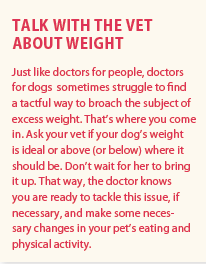A number of years ago, the American Animal Hospital Association published a chart listing a number of things that stand in the way of weight loss for overweight dogs. Topping the chart: begging. Also way up there: guilt on the part of the pet “parent.”
We get it. Your dog looks at you with those big, beseeching eyes, not budging from her spot even when you try to ignore her. So finally, you give in. That doesn’t make you a bad dog guardian. It makes you a soft touch. But you’re not doing your pet any good. As we’ve said before, overweight dogs live, on average, two years less than their counterparts who remain at ideal body condition. They get sicker during their lives, too. Excess weight makes a dog more prone to respiratory and skin disorders, kidney dysfunction, hormone-related diseases like diabetes, and conditions that cause a lot of pain, such as arthritis. Too many pounds have even been associated with certain types of canine cancer.
With more than half of all pet dogs in the U.S. estimated to be overweight, that’s far too many at unnecessary risk. The good news: you can keep your pet from angling for excess food without making her feel deprived. It’s all about redirecting her attention. If you’ve ever tried to shed pounds yourself, you know what we mean. You might feel like eating in the absence of true hunger, but if you can find something absorbing to do, thinking about food goes away. Here’s how to make that happen for your pet — and score a secondary win in the bargain. A veterinary team writing for the American Animal Hospital Association has pointed out that dogs develop stronger bonds with people who engage in activities with them than with those who provide food.
When your dog angles for food…
1.Brush her. Fortunately, dogs are pretty distractible. So when the begging begins, begin brushing. Your dog will be happy because what she really wants is not food but your attention. This way she will have it.
2.Start a game of fetch. You can always take your dog for a walk when she starts pleading for a snack between meals, but you don’t have to. Getting her favorite toy and play-growling with it before you throw it to her should very quickly make her forget about the morsels she was after.
3.Divide food into more frequent, smaller meals. “Two meals a day” is not engraved in stone. If it would make your dog happy to be fed three or four times a day, that’s fine — as long as the day’s overall calorie allotment is the same no matter how many smaller meals you parcel it into.
4.Shake things up. New toys, new games, new walking routes — whatever engages your dog’s senses and satisfies her yearning for “more” will help her enjoy and then anticipate things other than food.
5. Make Meals Fun! Put part of a meal in one bowl in one room and the rest in a different  bowl in another. Don’t always use the same two (or three) spots. If your dog has to “hunt” for the goods, she will enjoy them all the more. It will also keep her from eating too fast if that’s one of her habits. Meals will last longer.
bowl in another. Don’t always use the same two (or three) spots. If your dog has to “hunt” for the goods, she will enjoy them all the more. It will also keep her from eating too fast if that’s one of her habits. Meals will last longer.
6. Remember that not overfeeding doesn’t mean “no treats.” But you can keep treats low-calorie — unbuttered, unsalted popcorn and low-starch vegetables like broccoli florets. Remember, it’s more important to your dog that you give her something than what that something is. And if she refuses to eat your low-calorie offerings, then she isn’t really hungry, is she?





